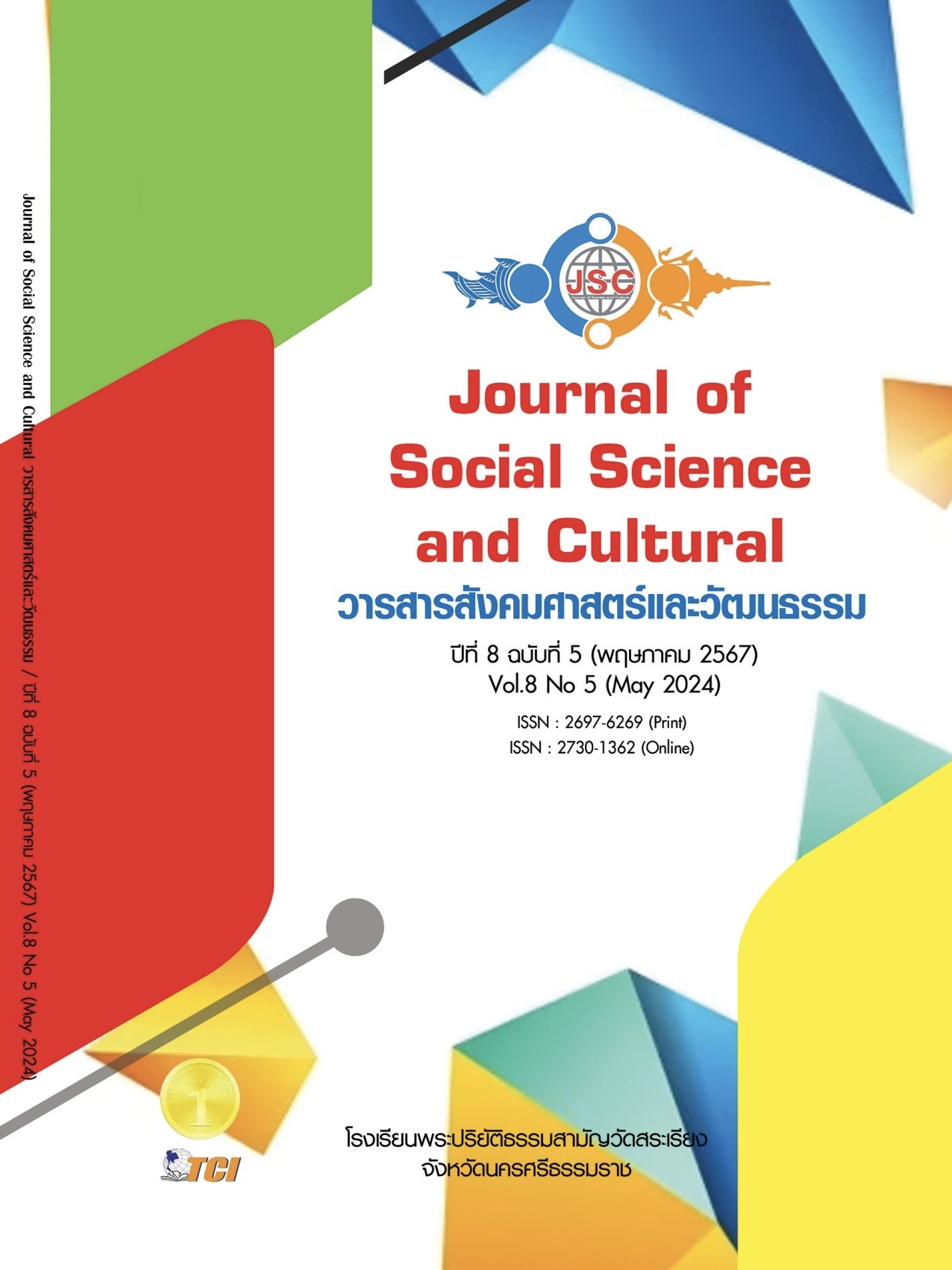STUDY OF MATHEMATICS ACHIEVEMENT BY USING SUUGAKU METHOD OF PRIMARY 2 STUDENTS HATYAI CITY KINDERGARTEN (NA SUWANNAWONG SCHOOL)
Main Article Content
Abstract
The research article aims to 1) compare the learning outcomes of second-grade elementary students in multiplication using the Japanese line method versus conventional multiplication learning methods, and 2) examine the satisfaction levels of a experimental group of second-grade elementary students towards the Japanese line method of multiplication learning. This research is experimental research. The population studied comprises second-grade elementary students in the first semester of the academic year 2024 from Hatyai city kindergarten (Na suwannawong school). The sample group consists of second-grade students selected through simple random sampling, totaling 2 classrooms, with each classroom representing mixed-ability learning. The research tools include lesson plans for Japanese line multiplication learning and conventional multiplication learning, post-learning outcome assessment tests with conformity indices ranging from 0.67 to 1.00, difficulty indices ranging from 0.31 to 0.75, discriminant power indices ranging from 0.33 to 0.79, and conformity indices between questions and objectives with confidence levels from 0.79. The satisfaction questionnaire for the experimental group students has a conformity index of 0.67 to 1.00. Statistical analysis utilized average values, standard deviations, and independent group mean comparisons. The research findings indicate that 1) students using the Japanese line multiplication learning method demonstrate significantly higher post-learning outcomes compared to those using conventional methods at a statistically significant level of .01, and 2) the satisfaction levels of the experimental group students towards the Japanese line multiplication learning method are exceptionally high (with a mean score of 4.73
Article Details
References
จุฑามาศ แกล้วทนงค์ และกรวิภา สรรพกิจจำนง. (2565). การเปรียบเทียบผลสัมฤทธิ์ทางการเรียนวิชาคณิตศาสตร์ เรื่อง การคูณของนักเรียนชั้นประถมศึกษาปีที่ 2 ระหว่างการสอนโดยใช้สื่อประสม ชุดการคูณแสนสนุกกับการสอนแบบปกติ. เรียกใช้เมื่อ 3 ตุลาคม 2566 จาก https://so02.tci-thaijo.org/index.php/JRKSA/article/view/253178.
น้ำลิน เทียมแก้ว. (2561). การศึกษาความพึงพอใจต่อคุณภาพการให้บริการ. รายงานการวิจัยสำนักวิทยบริการ, 2(1), 8-10.
บุญชม ศรีสะอาด. (2554). การวิจัยเบื้องต้น. (พิมพ์ครั้งที่ 9). กรุงเทพมหานคร: สุวีริยาสาส์น.
พล เหลืองรังษี. (2564). การวิจัยเพื่อพัฒนาการเรียนรู้. (พิมพ์ครั้งที่ 3). กรุงเทพมหานคร: สหมิตรพัฒนาการพิมพ์.
โยธิน ศิริเอ้ย. (2559). ความพึงพอใจที่มีต่อการจัดการเรียนการสอนในรายวิชาเทคโนโลยีสารสนเทศและการสื่อสาร รหัสวิชา ง32101 ชั้นมัธยมศึกษาปีที่ 5 ภาคเรียนที่ 2 ปีการศึกษา 2559. เรียกใช้เมื่อ 9 ตุลาคม 2566 จาก https://www.thoengwit.ac.th/projectkru/projdoc/55.pdf.
รัตนะ บัวสนธ์. (2562). การวิจัยและพัฒนานวัตกรรมการศึกษา. (พิมพ์ครั้งที่ 3). กรุงเทพมหานคร: สำนักพิมพ์จุฬาลงกรณ์มหาวิทยาลัย.
วันนิสา คลังคนเก่า. (2563). การใช้ชุดฝึกทักษะ เรื่อง การคูณที่มีต่อผลสัมฤทธิ์ทางการเรียน ของนักเรียนชั้นประถมศึกษาปีที่ 3. เรียกใช้เมื่อ 25 ตุลาคม 2566 จาก http://www.ska2.go.th/reis/data/research/25640629_144607_3725.pdf.
สถาบันส่งเสริมการสอนวิทยาศาสตร์และเทคโนโลยี กระทรวงศึกษาธิการ. (2560). คู่มือการใช้หลักสูตร กลุ่มสาระการเรียนรู้คณิตศาสตร์ (ฉบับปรับปรุง พ.ศ. 2560) ตามหลักสูตรแกนกลางการศึกษาขั้นพื้นฐาน. เรียกใช้เมื่อ 1 กุมภาพันธ์ 2567 จาก https://www.scimath.org/e-books/8922/flippingbook/index.html#1.
สำนักทดสอบทางการศึกษา สำนักงานคณะกรรมการการศึกษาขั้นพื้นฐาน. (2565). รายงานการทดสอบความสามารถพื้นฐานของผู้เรียนระดับชาติ (NT) ปีการศึกษา 2565. เรียกใช้เมื่อ 5 พฤศจิกายน 2566 จาก http://180.180.244.43/NT/ExamWeb/FrLogin.aspx.
Abuja, G. (2022). The Effect of Japanese Multiplication on Pupils Interest in Mathematics. ResearchGate, 2(1), 13-19.
Garain, D. & Kumar, S. (2019). Japanese vs Vedic Methods for Multiplication. International Journal of Mathematics Trends and Technology, 1(1), 56-57.
Nandi, B. (2022). It’s not magic, it’s math-how the Japanese multiplication method works. Joseph Sarwuan Tarka, 1(1), 1-4.
Tyovenda, A. (2022). The Effect of Japanese Multiplication on Students’ Achievement And Retention In Mathematics. International Research Journal of Modernization in Engineering Technology and Science, 6(2), 1-3.


